◄ Carnets Geol. 13 (A04) ►
[Introduction]
[Lithostratigraphy
...]
[Biostratigraphy ...]
[Cyclo- and sequence stratigraphy ...]
[The Orbitolinidae ...] [Discussion] [Conclusion]
[Bibliographic references] and ... [Plates]
Département des Sciences de la Terre, UFR des Sciences et Techniques, Université de Bretagne
Occidentale (UBO), 6, avenue Le Gorgeu, F-29238 Brest Cedex 3 (France)
24 ch. des Champs d'Amot, 74140 Messery (France)
Centre de Recherches Micropaléontologiques, Muséum d'Histoire
naturelle, 60 Bd Risso, 06000 Nice (France);
Laboratoire de Géologie des Systèmes et des Réservoirs
Carbonatés, Aix-Marseille Université, Campus St-Charles, Case 67, 3 Pl. Victor Hugo, 13331 Marseille Cedex 03 (France)
Chemin du Méruzin, 69370 St-Didier-au-Mont-d'Or (France)
Département de Géologie et Paléontologie, Université de Genève, 13 rue des Maraîchers, 1211 Genève 4 (Switzerland)
Laboratoire de Géologie des Systèmes et des Réservoirs Carbonatés, Aix-Marseille Université, Campus St-Charles, Case 67, 3 Pl. Victor Hugo, 13331 Marseille Cedex 03 (France)
24 avenue de Bel-Air, 1225 Chêne-Bourg (Switzerland)
Manuscript online since July 22, 2013
[Scientific editor:
Christian C. ; technical editor: Bruno ;
language editor: Stephen ]
Shallow-water assemblages of transported ("freshly reworked") bioclasts (mainly orbitolinids and dasycladales) are observed in the deeper facies of the "Vocontian Trough" (SE France). There these benthic assemblages can be directly correlated with ammonite zones. These new finds give an Early Barremian age to the earliest record of Palorbitolina lenticularis as well as those of four so-called "typical Early Aptian" representatives of the genus Orbitolinopsis. Actually most orbitolinid species recorded from the Late Barremian interval are now found present in Lower Barremian strata at L'Estellon. Some currently used correlation schemes for the Urgonian platforms, that are based on partial stratigraphic distribution ranges for the orbitolinids, --and consequently derived conclusions and hypotheses-- require at least in-depth revisions when they are not definitively refuted.
Barremian; Urgonian ; orbitolinids; Dasycladales; ammonites; biostratigraphy; biostratigraphic calibration.
B., B., M., R., J., G. & P. (2013).- L'Estellon (Baronnies, France), a "Rosetta Stone" for the Urgonian biostratigraphy.- Carnets de Géologie [Notebooks on Geology], Brest, Article 2013/04 (CG2013_A04), p. 163-207.
L'Estellon (Baronnies, France), une "Pierre de Rosette" pour la biostratigraphie de l'Urgonien.- Des associations d'organismes habituellement caractéristiques de faibles tranches d'eau (des orbitolinidés et des algues, en particulier) ont été identifiées dans des faciès relativement profonds de la "fosse vocontienne" (SE de la France), où ces éléments ont été transportés gravitairement et précocement resédimentés. Dans un tel contexte paléoenvironnemental, ces associations benthiques peuvent être directement calibrées sur les zones d'ammonites. D'après ces nouvelles observations, entre autres résultats, la première apparition de Palorbitolina lenticularis ainsi que celles de quatre représentants du genre Orbitolinopsis, soi-disant typiques de l'Aptien inférieur, sont datées du Barrémien inférieur. De fait la plupart des espèces d'orbitolinidés connues dans le Barrémien supérieur sont déjà présentes au Barrémien inférieur à L'Estellon. Concernant les plates-formes urgoniennes, les schémas de corrélations couramment utilisés, qui s'appuient sur des distributions biaisées (tronquées) d'orbitolinidés -- et par conséquent les conclusions et hypothèses qui en sont dérivées --, nécessitent au moins des révisions en profondeur, sinon un rejet définitif.
Barrémien ; Urgonien ; orbitolinidés ; Dasycladales ; ammonites ; biostratigraphie ; calibration biostratigraphique.
L'Estellon section ( et al.,
2013) is located some twenty kilometres north to the locality of Nyons in the Drôme department, SE France
(Fig. 1 ![]() ), a few kilometres north to the Chaudebonne section (,
1966) and south to the Crupies section (,
1976). As in both aforementioned sections the succession, which consists mostly of basinal marls and associated vermicular limestones (Fig.
2.C
), a few kilometres north to the Chaudebonne section (,
1966) and south to the Crupies section (,
1976). As in both aforementioned sections the succession, which consists mostly of basinal marls and associated vermicular limestones (Fig.
2.C ![]() ) includes a number of intercalations made of conglomerates (debris-flows) and oobioclastic allodapic calcarenites (turbidites). These coarse-grained floatstone and oobioclastic wackestone facies contain numerous foraminifers and calcareous algae thought to be transported ("freshly reworked") laterally from neighbouring carbonate shelves. While measuring the section
(Fig. 3
) includes a number of intercalations made of conglomerates (debris-flows) and oobioclastic allodapic calcarenites (turbidites). These coarse-grained floatstone and oobioclastic wackestone facies contain numerous foraminifers and calcareous algae thought to be transported ("freshly reworked") laterally from neighbouring carbonate shelves. While measuring the section
(Fig. 3 ![]() ) we also collected in the argillaceous and muddy limestones a rather diversified ammonite fauna composed of Late Hauterivian and (Early and Late) Barremian forms ( et al.,
2013). The co-occurrence of both shallow- and deeper- water fossils allowed us to reconfirm the calibration of the First Appearance Datum - FAD - (and eventually the Last Appearance Datum - LAD -, because this parameter may be affected by late reworking phenomena) of these benthic foraminifers (,
1966, 1974; et al.,
2007,
2010a, 2010b, 2010c) and algae ( et al.,
2007; ,
2013a) using the ammonite biozones. In other words L'Estellon section helped us correlating the distribution of allochtonous neritic ("shallow-water") assemblages with time-equivalent subautochtonous pelagic ("deeper-water") components of the fossil record and it provides therefrom a mean to transcript them into ages. Thus, L'Estellon section can be regarded as a "Rosetta Stone" for the Urgonian biostratigraphy. A comparison of these updated microfossil appearances with their ranges shown on current orbitolinid charts ( et al.,
2005; et al.,
2007,
2010a) provide contrasting results: for instance, our results call for the definitive withdrawal of one chart ('s that denies Lower Barremian occurrences as documented herein) and lead to question the conclusions of the several publications relying on such biostratigraphic framework (see similar discussions in et al.,
2012, and et al.,
2013).
) we also collected in the argillaceous and muddy limestones a rather diversified ammonite fauna composed of Late Hauterivian and (Early and Late) Barremian forms ( et al.,
2013). The co-occurrence of both shallow- and deeper- water fossils allowed us to reconfirm the calibration of the First Appearance Datum - FAD - (and eventually the Last Appearance Datum - LAD -, because this parameter may be affected by late reworking phenomena) of these benthic foraminifers (,
1966, 1974; et al.,
2007,
2010a, 2010b, 2010c) and algae ( et al.,
2007; ,
2013a) using the ammonite biozones. In other words L'Estellon section helped us correlating the distribution of allochtonous neritic ("shallow-water") assemblages with time-equivalent subautochtonous pelagic ("deeper-water") components of the fossil record and it provides therefrom a mean to transcript them into ages. Thus, L'Estellon section can be regarded as a "Rosetta Stone" for the Urgonian biostratigraphy. A comparison of these updated microfossil appearances with their ranges shown on current orbitolinid charts ( et al.,
2005; et al.,
2007,
2010a) provide contrasting results: for instance, our results call for the definitive withdrawal of one chart ('s that denies Lower Barremian occurrences as documented herein) and lead to question the conclusions of the several publications relying on such biostratigraphic framework (see similar discussions in et al.,
2012, and et al.,
2013).

Click on thumbnail to enlarge the image.
Figure 1: Geographic location of L'Estellon section. © www.geoportail.fr & IGN - Institut Géographique National, 73 avenue de Paris, F-94165 Saint-Mandé Cedex (France).
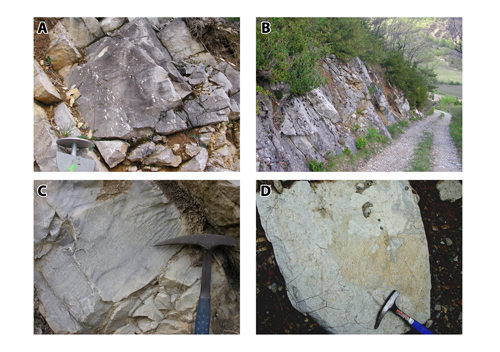
Click on thumbnail to enlarge the image.
Figure 2: A: cherts in calcarenites of the interval 227.1 to 228.2; B: uppermost part of the section, temporary end at level 243.7; C: typical vermicular (bioturbated) facies; D: Zoophycos at level 241.2.
One of the initial objectives when measuring the section at L'Estellon (Chaudebonne commune, Drôme department) was to revise and better characterize a lithostratigraphic unit
labelled with a double-barrelled name, i.e., "Barrémo-Bédoulien", on the regional geological maps (Nyons: et al.,
1975; Dieulefit: , ed.,
1969). We used a 's staff
(Fig. 4.D ![]() ) to measure the section along the track (L'Adret et Crema) going down from the Charbonnière farm to the Borne farm, east of the hamlet of Les Nauds (L'Estellon). There strata are oriented N130 to N150° E with a dip 50 to 60° SW.
) to measure the section along the track (L'Adret et Crema) going down from the Charbonnière farm to the Borne farm, east of the hamlet of Les Nauds (L'Estellon). There strata are oriented N130 to N150° E with a dip 50 to 60° SW.

Click on thumbnail to enlarge the image.
Figure 3: Lithostratigraphic column of L'Estellon section.
The section starts near the Charbonnière farm (Fig. 1 ![]() ) at an altitude of about 780 m (upstream) in the more or less regular alternating marls and limestones classically referred to the Hauterivian
(Fig. 3
) at an altitude of about 780 m (upstream) in the more or less regular alternating marls and limestones classically referred to the Hauterivian
(Fig. 3 ![]() ). At level 26.5m we observed an isolated calcarenitic bed (1.1m thick) followed by occurrences of more or less thick calcarenitic, as well as conglomeratic, intercalations at levels 49.3
(Fig. 4.B
). At level 26.5m we observed an isolated calcarenitic bed (1.1m thick) followed by occurrences of more or less thick calcarenitic, as well as conglomeratic, intercalations at levels 49.3
(Fig. 4.B ![]() ), 60.7, 77.2, 81.7, 92.1, and 117.4m. Higher in the section, two very thick and dominantly calcarenitic intervals at 137.0 to 174.1
(c. 37m thick) and 217.0 to 240.0 (c. 23m thick,
Fig. 2.A-B
), 60.7, 77.2, 81.7, 92.1, and 117.4m. Higher in the section, two very thick and dominantly calcarenitic intervals at 137.0 to 174.1
(c. 37m thick) and 217.0 to 240.0 (c. 23m thick,
Fig. 2.A-B ![]() )
correspond to the so-called "Barremian" and "Bedoulian" ridges respectively. The section, which almost reaches 250m in thickness, ends at an altitude of about 710m (downstream) without reaching the next lithostratigraphic unit (i.e., Aptian-Albian "Marnes bleues").
)
correspond to the so-called "Barremian" and "Bedoulian" ridges respectively. The section, which almost reaches 250m in thickness, ends at an altitude of about 710m (downstream) without reaching the next lithostratigraphic unit (i.e., Aptian-Albian "Marnes bleues").
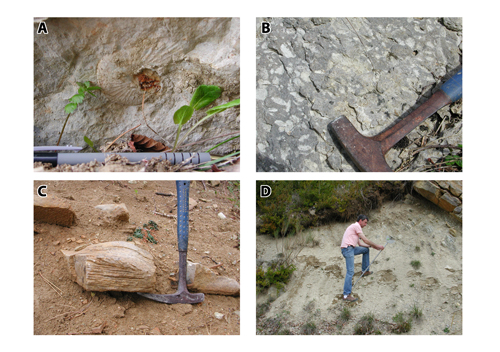
Click on thumbnail to enlarge the image.
Figure 4:
A:
Phyllopachyceras sp. at level 17; B: conglomerate with marl pebbles (intraclasts) at level 54.5, see also
Fig. 5 ![]() ;
C: calciturbidite with E. s F7 facies (flat lamination capped by small unidirectional ripples);
D: measuring of the section with the s staff.
;
C: calciturbidite with E. s F7 facies (flat lamination capped by small unidirectional ripples);
D: measuring of the section with the s staff.
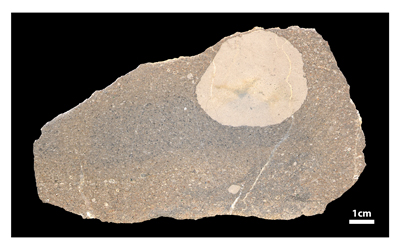
Click on thumbnail to enlarge the image.
Figure 5: rounded mudstone pebble (intraclast) floating in a bioclastic grainy matrix at level 194.5.
A parallel objective when measuring the section was to revise the biostratigraphy of the so-called "Barrémo-Bédoulien". This revision is based on a significant number of ammonites collected in the section and also consideration that the planktonic and deeper-water benthic foraminifers from four marly samples taken at levels 63.3, 77.2, 116 and 242m are autochtonous.
The inventory of our first collection (2012 campaign) led to identify Late Hauterivian and Barremian taxa, as well as some taxa that straddle the Barremian-Bedoulian boundary, but no typically Bedoulian taxa ( et al., 2013). Actually, as shown by several authors (e.g., , 1966; , 1997; & , 2003) in the Vocontian Basin the Bedoulian interval, which is sited at the bottom of the "Marnes bleues", is condensed and even partly lacunary.
Based on the sole ammonite record, the studied interval was first subdivided as follows ( et al., 2013):
Most Barremian ammonite zones have been detected but their boundaries were not accurately defined. For instance, in the Lower Barremian interval, we were not able to separate the Hugii and Nicklesi zones. As for the Upper Barremian interval the assemblage at level 125 is diagnostic of the Vandenheckei Zone; the index of the Sartousiana Zone is found in levels 187-188 and the Sarasini Subzone of the Giraudi Zone possibly begins above level 195.5 with Hemihoplites sp. and Acantholytoceras sp. and below level 202 with Heteroceras sp. As said above, the Bedoulian (sensu et al., 2011) was not identified in the section.
(1966) already reported scarce occurrences of small planktonic foraminifers and deep-water benthic foraminifers from Vocontian Barremian sections, such as that of Chaudebonne, a few kilometres from L'Estellon. Similar microfaunas have been found in the washed residues of the four marly samples quoted above, including specimens that contributed to date some intervals.
At levels 60.3 and 77.2 (marly samples 1 and 2), the occurrence of rare and evolutionary-primitive forms of Praehedbergella eocretacea, a planktonic marker of the upper Lower Barremian (, 1966), suggests that these levels should be ascribed to the Compressissima Zone.
At level 242 (marly sample 4), we found Praehedbergella primare ( & ). The FAD of this species falls in the "vire à Heteroceras" auct. (i.e., in the interval between the so-called "Barremian" and "Bedoulian" ridges) in the Vocontian Basin (at Angles for instance, cf. & , 1965; , 1966). Among the deeper-water benthic foraminifers occurs the species Lenticulina cuvillieri , the LAD of which has been found near the Barremian - Bedoulian boundary at Cassis ( et al., 1998), and Gavelinella sp. aff. barremiana (sensu , 1966), common in Barremian strata, but very rare in Bedoulian ones. Therefore on the basis of foraminifers level 242 can be ascribed to the latest Barremian. This result is consistent with the dating based on our ammonite record.
The ≥ 200 µm size fraction of three of the four samples collected from L'Estellon section included a more or less important amount of fragments from various Invertebrates (such as Bivalves, Echinids, Gastropods, Sponges, Algae, ...) and abraded tests of shallow water benthic larger foraminifers, mostly Orbitolinids. The < 200 µm fractions contained some abraded medium sized shallow water benthic foraminifers (Miliolids, Lituolids, ...). In all samples, finer fractions included rare smaller, better preserved, supposedly deeper water benthic foraminifers (Lenticulinids, Gavellinids, Praedorothias, ...) and also very rare tiny planktonics (Praehedbergellas).
The bioclasts and abraded shallow water benthic microfossils are thought to originate from the neighbouring carbonate platforms such as the Vercors, northern Diois or Ardèche. They were submitted to intraformational reworking and rapidly transported in the Vocontian Basin. The tiny and scarce better preserved benthics and planktonics are interpreted as being the autochtonous basinal microfauna.
Benthic foraminifers : Lenticulina gibba, Neotrocholina paucigranulata, Spirillina minima, Patellina subcretacea, Nodosariidae sp. pl., indet. small abraded rotaliiforms, Conorboides sp., Epistomina sp., Gavelinella sp. aff. barremiana (sensu , 1966), Spiroplectammina sp., Praedorothia ouachensis. Few abraded Orbitolinids and Miliolids.
Planktonic foraminifers : Gorbachikella kugleri, Praehedbergella eocretacea, P. sigali.
Benthic foraminifers : Neotrocholina infragranulata, N. paucigranulata, Spirillina minima, Patellina subcretacea, Praedorothia sp. pl., including P. sp. gr. hechti-subtrochus, P. trochus, P. ouachensis, Globorotalites bartensteini bartensteini, Lenticulina cuvillieri. Numerous abraded shallow-water larger foraminifers, such as Orbitolinids, Miliolids, Choffatellas, Pseudocyclamminas, Trocholina aptiana, and smaller ones, as Arenobulimina sp.pl., Nezzazata, Nautiloculina, Conorboides sp. pl., various undetermined rotaliiforms.
Planktonic foraminifers : Praehedbergella sigali, P. eocretacea, P. aptiana.
Benthic foraminifers : Lenticulina crassa, L. gibba, Reophax sp. gr. minuta-guttifer, Trochammina cf. vocontiana, Neotrocholina infragranulata, N. paucigranulata, Spirillina minima, Patellina subcretacea. This level does not contain abraded "reworked" elements of a shallow water allochtonous microfauna.
Planktonic foraminifers : Praehedbergella sigali, P. aptiana.
Benthic foraminifers : common Lenticulina cuvillieri, rare L. ouachensis ouachensis, L. ouachensis multicella, Gavelinella sp. aff. barremiana (in , 1966). Few abraded forms, such as Orbitolinids, Miliolids (Triloculina sp., Spiroloculina sp., ...), Pseudolituonella ? sp.
Planktonic foraminifers : Praehedbergella sigali, P. aptiana, P. primare.
As for the calcareous algae, we did not use them to date the turbidites. However it is noteworthy to mention that we do not report out of range occurrences. For instance, the LAD of the recently revised Clypeina paucicalcarea is found at L'Estellon up to level 92.3 (,
2013a) in the Moutonianum Zone, i.e., in the uppermost ammonite zone of the Lower Barremian, that is consistent with our current knowledge of its stratigraphic range. Another species, Salpingoporella genevensis, which was never reported in strata higher than the Lower Barremian, is found at L'Estellon in the first calcarenitic bed in samples 26.5
(Fig. 6.A ![]() ) and 72.
) and 72.
In Serre de Bleyton, a locality 6 km eastward of L'Estellon, a "sand sheet" dated "middle to late Early Barremian" by its ammonite assemblage (, 2010) also contains foraminifers and algae. But only the algae were studied by (2011) who lists: Clypeina (as "Pirifirella") paucicalcarea, Actinoporella "gr." podolica (see discussion in , 1995), Angioporella fouryae, Deloffrella quercifoliipora, Falsolikanella danilovae (see discussion in et al., 2000), Montiella ? elitzae, Pseudoactinoporella fragilis, Pseudoclypeina sp., Russoella radoicicae, Salpingoporella genevensis, S. melitae, S. muehlbergii, and Triploporella sp.
Some Dasycladales, which are easy to identify, proved to be useful fossils to discriminate Lower from Upper Barremian strata. There are cases where some authors purposely do not deliver such information because it might contradict their biostratigraphic interpretation (see discussions in et al., 2012, or et al., 2013).
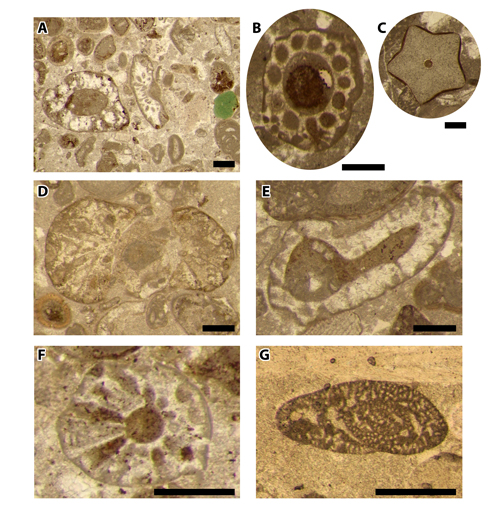
Click on thumbnail to enlarge the image.
Figure 6: A: slightly glauconitic oobioclastic wackestone with the algae Salpingoporella genevensis (oblique section) and Actinoporella gr. podolica (oblique section) - Sample 26.5m; B: subtransverse section of a charophyte stem - Sample 218.1m; C: transverse section of a crinoid columnal - Sample 218.1m; D: oblique section of the alga Falsolikanella danilovae - Sample 92.3m; E: branching thallus (rare) of the alga Salpingoporella muelhbergii - Sample 92.3m; F: oblique section of the alga Pseudoactinoporella fragilis - Sample 26.5m; G: the benthic foraminifer Choffatella decipiens - Sample 49.8m. Scale bar = 500µm.
L'Estellon is located only c. 20 km westward of La Charce, a candidate for the GSSP - Global Boundary Stratotype Section and Point - of the Hauterivian. In most localities of the Vocontian Basin the stratal pattern of Hauterivian marl-limestone alternations is correlated to cyclic variation in the pelagic carbonate Praedictyorbitolina, which is interpreted as the record of climatic oscillations, which in turn are controlled by orbital parameters (see ,
1993). In fact, a marl-limestone couplet would correspond to a
c. 21 kyr precession of the equinoxes cycle. A couplet, 0.8 to 1.0m thick in average, took some 21 kyr for sedimentation whereas discrete calcarenitic intercalations, ranging from 0.01 to 1.0m in thickness, were probably deposited in less than one hour
(Fig. 7.A ![]() ). The sand-sized allochems found in these mud-supported (wackestone) or eventually grain-supported (grainstone) textures are mostly bioclasts: echinoderms, bryozoans, pelecypods, benthic foraminifers, calcareous green algae, etc. The coarser grains floating in the muddy or grainy matrices are intraclasts (basinal mudstones and marlstones) and extraclasts (shallow-water carbonate facies). At L'Estellon, except for the intraclasts
(Figs. 4.B
). The sand-sized allochems found in these mud-supported (wackestone) or eventually grain-supported (grainstone) textures are mostly bioclasts: echinoderms, bryozoans, pelecypods, benthic foraminifers, calcareous green algae, etc. The coarser grains floating in the muddy or grainy matrices are intraclasts (basinal mudstones and marlstones) and extraclasts (shallow-water carbonate facies). At L'Estellon, except for the intraclasts
(Figs. 4.B ![]() - 5
- 5 ![]() ), the source for this reworked material is to be found in the carbonate shelves surrounding the Vocontian Basin, probably from the West (see ,
1976), i.e., from the neighbouring Vivarais (Ardèche department), according to the paleocurrent directions and orientation.
), the source for this reworked material is to be found in the carbonate shelves surrounding the Vocontian Basin, probably from the West (see ,
1976), i.e., from the neighbouring Vivarais (Ardèche department), according to the paleocurrent directions and orientation.
Calcareous turbidites differ from siliciclastic turbidites in that they are not linked to upflow canyons incising the platform but most probably result from collapses of the unconsolidated accumulations at the platform edge
(Fig. 7.B ![]() ).
Theorically, it is almost excluded that such synsedimentary events occur at times of faster relative sea-level rise, i.e., during transgressive intervals (TST); instead, they may occur at times of slow relative sea-level rise, i.e., mostly during both late hightstand (HST) and lowstand (LST) intervals, and obviously at times of relative sea-level fall, i.e., mostly during "falling-stage" intervals (early LST).
).
Theorically, it is almost excluded that such synsedimentary events occur at times of faster relative sea-level rise, i.e., during transgressive intervals (TST); instead, they may occur at times of slow relative sea-level rise, i.e., mostly during both late hightstand (HST) and lowstand (LST) intervals, and obviously at times of relative sea-level fall, i.e., mostly during "falling-stage" intervals (early LST).
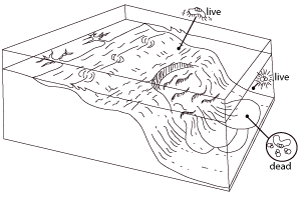
|
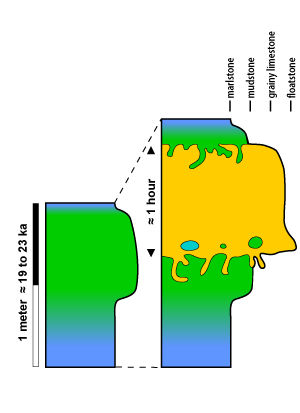
|
A |
B |
Click on thumbnail to enlarge the image.
Figure 7: A: a model for the sourcing of the Urgonian calciturbidites, the strata where the neritic microfossils meet the basinal index fossils (according to , 2013b); B: a model of the sedimentation rate for calciturbidites in alternating marl-limestone: for an equal thickness a calcarenitic interval represents a much higher sedimentation rate than a marl-limestone interval.
In a parallel paper ( et al., 2013) we identified a number of sand flow units at L'Estellon, ascribing them ammonite-derived ages and referring them to discrete LST in a set of sequences labelled Ba1 to Ba5, as identified by et al. (2010a, 2010b, 2010c, 2012). The list of units, their relative datings and their labellings follow:
One can agree or not with these interpretations, but this will not affect our dates, which are consolidated herein using planktonic and deeper-water benthic foraminifera.
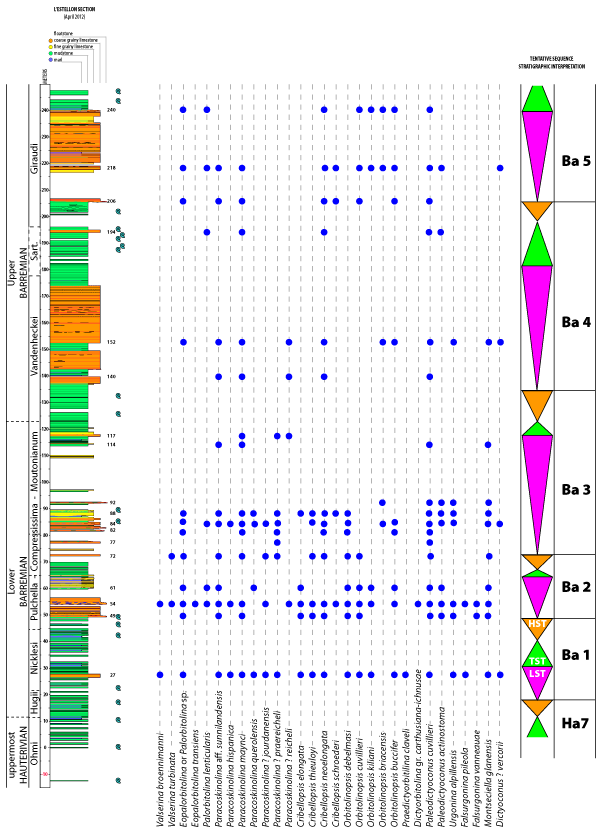
Click on thumbnail to enlarge the image.
Figure 8: Orbitolinid records together with the latest biostratigraphic interpretation of L'Estellon section as documented by ammonites and planktonic foraminifera (and tentative sequence stratigraphic framework).
About 100 kg of calcarenites were collected while measuring L'Estellon section. Though we sampled the whole section, we decide to focus on its Lower Barremian part. This material was cut and polished in order to locate and then obtain the best diagnostic sections of the several
Orbitolinid taxa. As a result the 75 kg of polished samples correspond to a total surface area of some
5m2, i.e., a surface equivalent to about 5750 classical petrographic slides (each representing a 8.64
cm2 surface). The 670 most diagnostic and better preserved specimens observed on these polished sections were photographed. Then part of this material (304 samples) was used to manufacture petrographic/micropaleontologic slides, i.e., regular thin sections 30µm thick in average. During the mechanical processing, some specimens were unfortunately destroyed: however they are figured here with the label "polished sections". Owing to the reworking and transport of the
L'Estellon material, a very large amount of the several thousands of orbitolinids collected are eroded, broken or recrystallized: therefore the best preserved specimens are those showing two or more clearly identifiable structures. It is worth mentioning that, in some cases, the polished sections give a better picture than the classical thin sections. Our
Figure 9.A ![]() , for instance, illustrates this fact: there the vertical marginal plates at the top of a Cribellopsis schroederi are clearly visible in the polished section while they can only be inferred in the resulting petrographic slide.
, for instance, illustrates this fact: there the vertical marginal plates at the top of a Cribellopsis schroederi are clearly visible in the polished section while they can only be inferred in the resulting petrographic slide.
A |
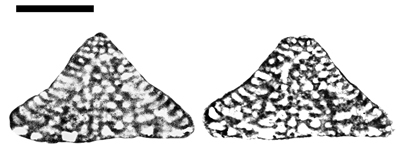
|
B |
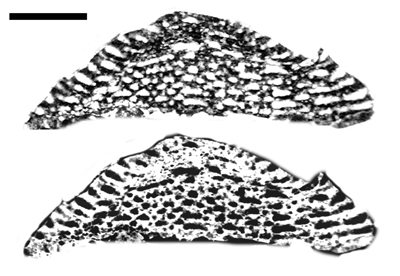
|
Click on thumbnail to enlarge the image.
Figure 9: A: polished section (left) and slide (right) of Cribellopsis schroederi - sample LEST-72; B: positive (up) and negative (down) subtangential sections of Orbitolinopsis buccifer, Pont de Laval section (Vivarais) - sample PL77. Scale bars = 500µm.
Class Foraminifera d', 1826
Subclass Textulariia , 1980
Order Loftusiida , 2004
Suborder Orbitolinina , 2004
Superfamily Orbitolinacea , 1890
Family Orbitolinidae , 1890
Subfamily Dictyoconinae , 1965
1) Genus Cribellopsis , 1980
Type-species: Orbitolinopsis ? neoelongata & , 1978.
Diagnosis (after , 1980):
Cribellopsis elongata ( et al., 1963)
Pl. 5 ![]() ,
figs. 1-5, 18 & 20
,
figs. 1-5, 18 & 20
This small species, characterized by a narrow central zone and a relatively voluminous trochospire, is common in the Upper Hauterivian and Lower Barremian strata, with its LAD in the Moutonianum Zone.
Illustrated specimens from samples 27, 49.5, 53.5 and 54.
Cribellopsis neoelongata ( & , 1978)
Pl. 5 ![]() ,
figs. 9-14; Pl. 9
,
figs. 9-14; Pl. 9 ![]() ,
fig. 9; Pl. 10
,
fig. 9; Pl. 10 ![]() , fig. 10
, fig. 10
Cribellopsis neoelongata differs from C. elongata by its larger size, sharp eccentric apex, widest central zone and by its adult chambers tending to shrink in diameter. Rarely found in Upper Hauterivian strata, this species becomes common in the Lower Barremian, where --sometimes depending on the orientation of the section-- it can be confused with C. elongata.
Illustrated specimens from samples 53.5, 54, 72, 84.5, 152.5 and 205.8.
Cribellopsis schroederi (, 1980)
Fig. 9.A ![]() ;
Pl. 5
;
Pl. 5 ![]() ,
figs. 15-16; Pl. 10
,
figs. 15-16; Pl. 10 ![]() ,
figs. 9 & 11
,
figs. 9 & 11
Cribellopsis schroederi has a very large central zone and a sharp slightly eccentric apex. Unlike C. neoelongata, its adult chambers increase regularly in diameter. It is known from the Early Barremian to the late Bedoulian, but it is always rather uncommon .
Illustrated specimens from samples 54 and 218.
Cribellopsis thieuloyi , 1980
Pl. 5 ![]() ,
figs. 6-8 & 17
,
figs. 6-8 & 17
This large-sized cylindro-conical Cribellopsis shows a reduced central zone and a marginal zone widening out in its adult chambers. It is restricted to the uppermost Hauterivian-Lower Barremian interval.
Illustrated specimens from samples 54, 72 and 88.2.
2) Genus Dictyorbitolina , 1900
Type-species: Patellina egyptiensis , 1900.
Diagnosis (after , 1980):
Dictyorbitolina ? vercorii , 1980
Pl. 8 ![]() ,
figs. 10-12; Pl. 9
,
figs. 10-12; Pl. 9 ![]() ,
fig. 7; Pl. 10
,
fig. 7; Pl. 10 ![]() ,
figs. 4
,
figs. 4
Provisionally attributed to the genus Dictyorbitolina, D. ? vercorii is rare in Lower Barremian strata but common in the Upper Barremian-lower Bedoulian interval. This species presents a small trochospire, a well developed marginal zone, and a central zone with short massive pillars, thick chamber walls and very large oblique or vertical pores.
Illustrated specimens from samples 26,6, 54, 72, 84.5, 152.5 and 218.
3) Genus Falsurgonina & , 1973
Type-species: Falsurgonina pileola & , 1973.
Diagnosis (after , 1980):
Falsurgonina pileola & , 1973
Pl. 6 ![]() ,
figs. 4-7, 11-12 & 14-15 & 18
,
figs. 4-7, 11-12 & 14-15 & 18
Falsurgonina pileola presents both small microspheric as well as wider megalospheric conical forms. Most of the time, both are laterally compressed.
Illustrated specimens from samples 26.2, 27 and 54.
Falsurgonina vanneauae et al., 2009b
Pl. 6 ![]() ,
figs. 8-10
,
figs. 8-10
Compared with Falsurgonina pileola, F. vanneauae, first described as Falsurgonina sp. 1 by (1980), is mainly characterized by its concave chambers and by the thickness of their structures. The existence of both micro- and megalo- spheric forms has not yet been evidenced.
Illustrated specimens from sample 54.
4) Genus Montseciella & , 1999a
Type-species: Paleodictyoconus glanensis , 1968.
Diagnosis (after & , 1999a):
Montseciella glanensis (, 1968)
Pl. 6 ![]() ,
figs. 13, 16-17 & 19-21; Pl. 8
,
figs. 13, 16-17 & 19-21; Pl. 8 ![]() ,
fig. 13; Pl. 9
,
fig. 13; Pl. 9 ![]() ,
fig. 5
,
fig. 5
This species is the only representative of the genus which does not have horizontal plates in the marginal zone. Axial/subaxial sections show a very developed marginal zone with large chamberlets decreasing in size and height in the central zone. Oblique subtangential sections exhibit chamberlets broader than high and hexagonal in outline.
Illustrated specimens from samples 26.6, 27, 54, 72, 84.5, 88.2 and 152.5.
5) Genus Orbitolinopsis (, 1932)
Type-species: Orbitolina ? kiliani , 1932.
Diagnosis (after , 1980):
Orbitolinopsis briacensis , 1980
Pl. 2 ![]() ,
figs. 17 & 20; Pl. 10
,
figs. 17 & 20; Pl. 10 ![]() ,
figs. 1-3
,
figs. 1-3
Orbitolinopsis very similar to O. kiliani, except the presence of vertical plates in the marginal zone.
Illustrated specimens from samples 54, 84.5 and 218.
Orbitolinopsis cf. briacensis , 1980
Pl. 9 ![]() ,
fig. 4
,
fig. 4
Illustrated specimen from sample 152.5.
Orbitolinopsis buccifer & , 1972
Pl. 2 ![]() ,
figs. 11, 13-14 & 18-19; Pl. 9
,
figs. 11, 13-14 & 18-19; Pl. 9 ![]() ,
figs. 11-15; Pl. 11
,
figs. 11-15; Pl. 11 ![]() ,
fig. 7
,
fig. 7
Large conical to flattened Orbitolinopsis with the size of the marginal zone widening out up to constitute the whole annular chamber layer.
Illustrated specimens from samples 26.6, 54, 61 (sample 58), 82.7, 152.5, 205.8, 218 and 240.
Orbitolinopsis cuvillieri , 1960
Pl. 2 ![]() ,
figs. 1-5, 8-10, 12, 16 & 21; Pl. 9
,
figs. 1-5, 8-10, 12, 16 & 21; Pl. 9 ![]() ,
figs. 16-19
,
figs. 16-19
Orbitolinopsis cuvillieri is the most commonly collected species in the whole section. It presents a conical to cylindro-conical section, with large-sized cupules separated by a rather wide interval.
Illustrated specimens from samples 26.6, 27, 50, 54, 205.8, 217.85, 218 and 240.
Orbitolinopsis debelmasi & , 1965
Pl. 7 ![]() ,
figs. 1-5
,
figs. 1-5
The numerous specimens collected at L'Estellon are strictly identical to the types described and figured from another Chaudebonne outcrop, a few kilometers further (, 1966). Their main specific characters are the presence of vertical plates in the marginal zone and the large development of the central zone with regularly alternating cupules.
Illustrated specimens from samples 54 and 88.2.
Orbitolinopsis kiliani (, 1932)
Pl. 2 ![]() ,
figs. 6-7 & 15; Pl. 9
,
figs. 6-7 & 15; Pl. 9 ![]() ,
figs. 20-21; Pl. 11
,
figs. 20-21; Pl. 11 ![]() ,
fig. 8
,
fig. 8
Orbitolinopsis of equal width and height, showing a pronounced alternation between large and very small bright areas ("lumina") in the axial sections and triangular cupules in close proximity.
Illustrated specimens from samples 27, 54, 61 (sample 58) and 218.
6) Genus Paleodictyoconus & , 1966
Type-species: Dictyorbitolina cuvillieri , 1963.
Diagnosis (after , 1980):
Paleodictyoconus cuvillieri (, 1963)
Pl. 5 ![]() ,
fig. 19; Pl. 7
,
fig. 19; Pl. 7 ![]() ,
figs. 6-8; Pl. 9
,
figs. 6-8; Pl. 9 ![]() ,
fig. 8
,
fig. 8
Paleodictyoconus characterized by convex chamber layers up to the adult stage.
Illustrated specimens from samples 54, 82.7, 84.5 and 152.5.
Paleodictyoconus actinostoma & , 1976
Pl. 7 ![]() ,
figs. 9-10; Pl. 10
,
figs. 9-10; Pl. 10 ![]() ,
fig. 12
,
fig. 12
Paleodictyoconus essentially defined by its sigmo-septal to annular adult chambers.
Illustrated specimens from samples 54, 61 (sample 58) and 218.
7) Genus Urgonina & , 1965
Type-species: Urgonina protuberans & , 1965.
Diagnosis (after , 1980):
Urgonina alpillensis (, 1963)
Pl. 6 ![]() ,
figs. 1-3; Pl. 9
,
figs. 1-3; Pl. 9 ![]() ,
fig. 6
,
fig. 6
This species is considered in this work as the sole representative of the genus. On the basis of the huge amount of material collected from the Swiss Jura to the French Provence, we assume that the forms named protuberans ( & , 1965), "forme B" (, 1963: Pl. 3, figs. 1-2 & 5), "? sp. 1" and "cf. alpillensis" (, 1980) has strictly identical structures (including in their variations) and same time range.
Illustrated specimens from samples 54 and 152.5.
Subfamily Praedictyorbitolininae , 1990
8) Genus Dictyorbitolina & , 1975
Type-species: Dictyorbitolina ichnusae & , 1975.
Diagnosis (after , 1980):
Dictyorbitolina gr. carthusiana et al., 1990 - ichnusae & , 1975
Pl. 4 ![]() ,
figs. 10 & 12
,
figs. 10 & 12
Both Praedictyorbitolina carthusiana and Dictyorbitolina ichnusae are here provisionally treated as a single group: the embryonic apparatus, representing the most important - over even unique, according to et al. (1990) - character allowing to discriminate both species, cannot be observed in our specimens.
Illustrated specimens from sample 54.
9) Genus Praedictyorbitolina et al., 1990
Type-species: Praedictyorbitolina carthusiana et al., 1990.
Diagnosis (after et al., 1990):
Praedictyorbitolina claveli , 1994
Pl. 4 ![]() ,
figs. 13-14
,
figs. 13-14
P. claveli differs from P. carthusiana (see above under Dictyorbitolina gr. carthusiana et al., 1990 - ichnusae & , 1975) by its smaller size and its acute apical angle. Its identification in L'Estellon section is based on the size of the collected specimens.
Illustrated specimens from sample 26.6.
10) Genus Paracoskinolina , 1965
Type-species: Paracoskinolina sunnilandensis , 1955.
Diagnosis (after , 1980):
Paracoskinolina hispanica , 1976
Pl. 3 ![]() ,
figs. 1-6
,
figs. 1-6
The main characteristic of this large-sized conical species is the presence of hemipillars.
The "P. cf. hispanica" of (1980) from Chartreuse and southern Vercors have to be ascribed to P. querolensis & , 1981 (see this species).
Illustrated specimens from samples 26.6, 27 and 54.
Paracoskinolina ? jourdanensis ( & , 1965)
Pl. 4 ![]() ,
figs. 6-7
,
figs. 6-7
This species, as well as Paracoskinolina ? praereicheli and P. ? reicheli, are provisionally ascribed to the genus Paracoskinolina , 1965. It presents a well-developed trochospire, a relatively important marginal zone with some vertical plates, and a clearly differentiated central zone. Depending of the section orientation, mostly in deep tangential sections, the central part of each chamber is shifted downward with respect to its marginal counterpart; in axial sections, the structure of this central part becomes indistinguishable.
Illustrated specimens from samples 54 and 72.
Paracoskinolina maynci (, 1961)
Pl. 3 ![]() ,
figs. 7-13; Pl. 9
,
figs. 7-13; Pl. 9 ![]() ,
fig. 3; Pl. 10
,
fig. 3; Pl. 10 ![]() ,
figs. 5-7
,
figs. 5-7
High cylindro-conical large-sized Paracoskinolina with flanks tending to become rapidly sub-parallel. The marginal and central zones, approximately of the same width, are sometimes not easily distinguishable.
Illustrated specimens from samples 27, 54, 72, 84.5, 88.2, 117, 152.5, 205.8 and 218.
Paracoskinolina ? praereicheli ( et al., 2009a)
Pl. 4 ![]() ,
figs. 1-4; Pl. 8
,
figs. 1-4; Pl. 8 ![]() ,
fig. 14
,
fig. 14
Paracoskinolina ? praereicheli differs from P. ? reicheli (see this species) by the lack of horizontal plates in the marginal zone.
Illustrated specimens from samples 61, 72, 77, 88.2 and 117.
Paracoskinolina querolensis & , 1981
Pl. 4 ![]() ,
figs. 8-9
,
figs. 8-9
Small size highly cylindro-conical Paracoskinolina with a discrete but complete initial spire and a well-developed marginal zone. There is no more than 6-7 chamberlets in each chamber layer.
Illustrated specimens from samples 27 and 53.5.
Paracoskinolina ? reicheli (, 1956)
Pl. 4 ![]() ,
figs. 4 & 11; Pl. 9
,
figs. 4 & 11; Pl. 9 ![]() ,
figs. 1-2
,
figs. 1-2
Cylindro-conical to widened species with a slightly eccentric trochospire. The marginal zone shows conspicuous horizontal plates.
Illustrated specimens from samples 54, 117 and 152.5.
Paracoskinolina aff. sunnilandensis (, 1955)
Pl. 3 ![]() ,
figs. 14-18; Pl. 9
,
figs. 14-18; Pl. 9 ![]() ,
fig. 10; Pl. 10
,
fig. 10; Pl. 10 ![]() ,
fig. 8
,
fig. 8
Paracoskinolina sunnilandensis (, 1955) is the type of the genus. Our specimens are typical conical Paracoskinolina with slightly convex chamber layers, narrow marginal zone and central zone constituted by non alternating septules arranged in radiating straight lines. A comparison of our material with Albian specimens from the Bahamas Islands leads us to consider that both forms are likely identical: however, pending a systematic revision, the Hauterivian-Bedoulian European forms are treated as affine.
Illustrated specimens from samples 27, 54, 72, 84.5, 88.2, 140.5 and 218.
Subfamily Orbitolininae , 1890
11) Genus Eopalorbitolina in & , 1968
Type-species: Eopalorbitolina charollaisi in & , 1968.
Diagnosis (after , 1980):
Eopalorbitolina transiens ( & , 1999b)
Pl. 8 ![]() ,
fig. 9
,
fig. 9
Eopalorbitolina with a slightly eccentric embryonic apparatus showing a small alveolar layer in its uppermost part. As already noticed by & (1999b), this species appears under the name of "E. charollaisi" in 's (1980) work from the southern Vercors.
Illustrated specimen from sample 54.
12) Genus Palorbitolina , 1963
Type-species: Madreporites lenticularis , 1805.
Diagnosis (after , 1980):
Palorbitolina lenticularis (, 1805)
Pl. 1 ![]() ,
figs. 1-13; Pl. 11
,
figs. 1-13; Pl. 11 ![]() ,
figs. 1-6 & 9
,
figs. 1-6 & 9
Palorbitolina lenticularis was the sole representative of the genus until the description of P. ultima by et al. (2010). The latter gets a periembryonic ring that extends "downwards to the base of the embryonic chamber, but without covering completely its basal surface". In P. lenticularis, the diameter of megalospheric embryo varies from 0.185 to 0.225mm.
Illustrated specimens from samples 54, 61 (sample 58), 84.5, 194.5 and 218.
13) Genus Valserina & , 1968
Type-species: Valserina brönnimanni & , 1968.
Diagnosis:
Valserina broennimanni & , 1968
Pl. 8 ![]() ,
figs. 1-3, 5-6 & 8
,
figs. 1-3, 5-6 & 8
Valserina broennimanni is characterized by its eccentric embryonic apparatus, which looks like occupying a central position when the section is perpendicular to the axis of symmetry.
Illustrated specimens from samples 26.6, 27 and 54.
Valserina turbinata (, 1968)
Pl. 8 ![]() ,
figs. 4, 7 & 15
,
figs. 4, 7 & 15
Valserina turbinata is defined by the presence of subepidermal, discrete to conspicuous septules in the embryonic apparatus, and of a periembryonic ring more or less developed and visible. The diameter of their megalospheric embryo, ranging from 0.070 to 0.120mm, excludes any confusion with Palorbitolina lenticularis.
Illustrated specimens from samples 54, 61 and 72.
Remark: As in other southeastern France or north Tethyan outcrops, serious questions arise in L'Estellon about the group including the genera Valserina, Eopalorbitolina and Palorbitolina: besides some orbitolinids showing clearly the specific structures described and figured in the original diagnoses and in authors following comments, there are a lot of other specimens that do not respect the assigned specific characters (and were never raised in early works).
Compared to the orbitolinid fauna collected in the surrounding platforms (Vivarais and southern Vercors), the material from L'Estellon has the advantage of being issued from a single continuous outcrop covering the entire Barremian period, dated by significant ammonites and planktonic foraminifers.
In order to test the validity of existing scales ( et al., 2002; et al., 2005; et al., 2007, 2010a), we needed a reference framework. We selected the "distribution chart of Orbitolinids" given by et al. (2005) because with almost 50 taxa it was intended to give the most comprehensive list of species. However, to make this chart easier to read we introduced some but few simplifications. For instance, we did not discriminate between the varieties of Urgonina alpillensis, nor between primitive and advanced forms of Orbitolinopsis debelmasi, nor between Dictyorbitolina ? vercorii and Dictyorbitolina aff. vercorii. In addition, Valserina sp. 1 and Valserina broennimanni are treated as V. (gr.) turbinata whereas Praedictyorbitolina carthusiana is included in the group Dictyorbitolina ichnusae-carthusiana. Finally Rectodictyoconus ? cf. giganteus appears as Montseciella alguerensis and Falsurgonina sp. 1 as Falsurgonina vanneauae.
As for the Orbitolinids, we plotted our findings at L'Estellon on both the range chart given by et al.
(2005; herein Fig. 10 ![]() ) and on that presented by et al.
(2007, and from then regularly updated, the last time in
2010a; herein Fig. 11
) and on that presented by et al.
(2007, and from then regularly updated, the last time in
2010a; herein Fig. 11 ![]() ). The highest discrepancies are with s chart ( et al.,
2005; herein Fig. 10
). The highest discrepancies are with s chart ( et al.,
2005; herein Fig. 10 ![]() ): for instance, our first record of the well-known Palorbitolina lenticularis dates back from the Pulchella Zone of the Lower Barremian strata, instead of from the top of the Sartousiana Zone of the Upper Barremian; another example is given by four representatives (kiliani, buccifer, briacensis, and cuvillieri) of the genus Orbitolinopsis, which have been said to be Bedoulian (= "Early Aptian") in age, whereas we found that these taxa already occur in Lower Barremian strata. On the contrary, the best match was obtained with s
(2007,
2010a; herein Fig. 11
): for instance, our first record of the well-known Palorbitolina lenticularis dates back from the Pulchella Zone of the Lower Barremian strata, instead of from the top of the Sartousiana Zone of the Upper Barremian; another example is given by four representatives (kiliani, buccifer, briacensis, and cuvillieri) of the genus Orbitolinopsis, which have been said to be Bedoulian (= "Early Aptian") in age, whereas we found that these taxa already occur in Lower Barremian strata. On the contrary, the best match was obtained with s
(2007,
2010a; herein Fig. 11 ![]() ).
).
We did not plot our findings on the tentative phylogenetic lineage proposed by et al. (2002) because it deals with 7 species only; in addition one of them been restricted to the sole Late Hauterivian. However, the plot of s chart ichnusae s shows that these are in good accordance with the ranges given therein except for the two Valserina, V. primitiva (the first occurrence of which was brought down) and V. turbinata (the total range of which was shifted down).
In conclusion, the basinal section at L'Estellon fully confirms the synthetic orbitolinid ranges established on the basis of the study of 17 sections of south-eastern France as partly defended and announced at STRATI2010 ( et al.,
2010a, 2010b, 2010c,
2012, etc., and additional work nearing completion). There, in external platform settings, short orbitolinid-rich intervals are sandwiched by strata with significant
ammonites: for instance, the subtangential sections of large-sized Early Barremian Orbitolinopsis buccifer from
L'Estellon (Pl. 2 ![]() , figs. 11 & 14) correspond to a characteristic subaxial section
(Fig. 9.B
, figs. 11 & 14) correspond to a characteristic subaxial section
(Fig. 9.B ![]() ), which was not integrated in the material figured by et al.
(2010a) for the Nicklesi Zone in the Pont de Laval section (Vivarais).
), which was not integrated in the material figured by et al.
(2010a) for the Nicklesi Zone in the Pont de Laval section (Vivarais).
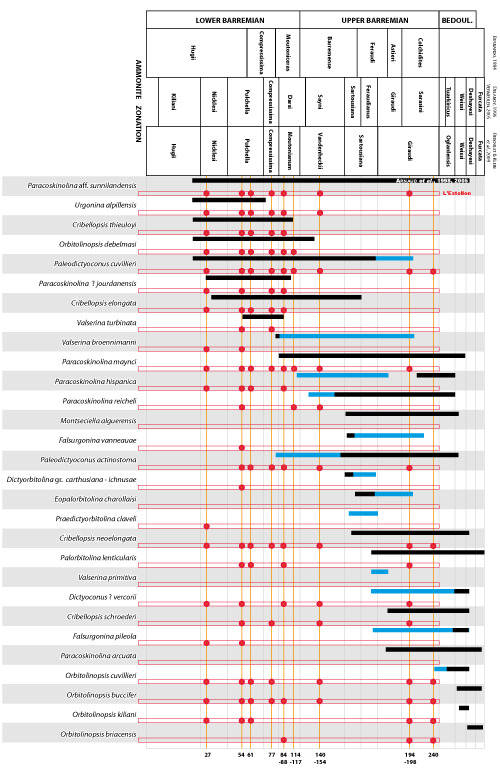
Click on thumbnail to enlarge the image.
Figure 10: Orbitolinids found at L'Estellon versus the distribution chart of Orbitolinids proposed by et al. (2005): black bars for the typical forms, blue bars for the related forms (primitive, advanced, cf., aff.).
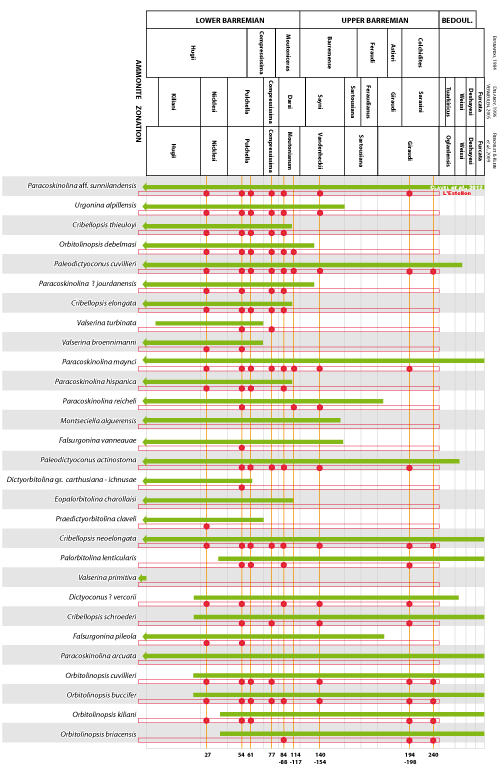
Click on thumbnail to enlarge the image.
Figure 11: Orbitolinids found at L'Estellon versus the distribution chart of Orbitolinids proposed by et al. (2007, 2010a).
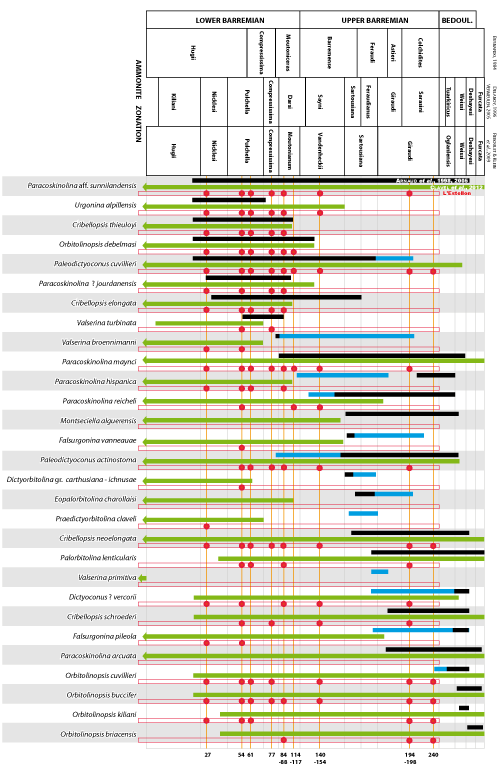
Click on thumbnail to enlarge the image.
Figure 12: Combination of the previous figures, that is the Orbitolinids found at L'Estellon versus the distribution charts of Orbitolinids proposed by et al. (2005) and by et al. (2007, 2010a).
After testing the validity of two distribution charts of Orbitolinids ( et al.,
2005; et al.,
2007,
2010a), we find that the highest discrepancies appear with s ( et al.,
2005; herein Fig. 10 ![]() ) and that by far the best match is obtained with s ( et al.,
2007,
2010a; herein Fig. 11
) and that by far the best match is obtained with s ( et al.,
2007,
2010a; herein Fig. 11 ![]() ), i.e., a range chart that is regularly consolidated by new sections (such as our new
Rosetta Stone, L'Estellon section; herein
Fig. 12
), i.e., a range chart that is regularly consolidated by new sections (such as our new
Rosetta Stone, L'Estellon section; herein
Fig. 12 ![]() ). As for previous publications ( et al.,
2012; et al.,
2013), we question the relevance of the conclusions and hypotheses of any published work based on the biased stratigraphic distribution ranges for the orbitolinids, i.e., any work based on s ( et al.,
2005, and earlier versions).
). As for previous publications ( et al.,
2012; et al.,
2013), we question the relevance of the conclusions and hypotheses of any published work based on the biased stratigraphic distribution ranges for the orbitolinids, i.e., any work based on s ( et al.,
2005, and earlier versions).
The first author (B.G.) would like to thank his colleagues from the University of Brest, Alain , who first guided him in the studied area in 2005, Jean-Alix and Pascal , who assisted him on the field (for
instance, during the last campaign in 2012), and a number of third year students who over the past eight years were successively requested to complete geological mapping
exercises in that area under his supervision and whose enthusiasm and curiosity were highly motivating factors. The 's staff used to measured the section
(Fig. 4.D ![]() )
was manufactured by Tanguy , during a training period at the Université de Bretagne occidentale, under the supervision of Bernard . Special thanks go to Mr. and Ms. Jean-Claude (Borne) and Mr. and Ms. Ronald (Charbonnière) for permitting access to their properties. This research was sponsored by the Association
"Carnets de Géologie". We also acknowledge the contribution of Stephen , who
ultimately revised the English text of the manuscript, and of two anonymous
reviewers.
)
was manufactured by Tanguy , during a training period at the Université de Bretagne occidentale, under the supervision of Bernard . Special thanks go to Mr. and Ms. Jean-Claude (Borne) and Mr. and Ms. Ronald (Charbonnière) for permitting access to their properties. This research was sponsored by the Association
"Carnets de Géologie". We also acknowledge the contribution of Stephen , who
ultimately revised the English text of the manuscript, and of two anonymous
reviewers.
A. (1980).- Micropaléontologie, paléoécologie et sédimentologie d'une plate-forme carbonatée de la marge passive de la Téthys : l'Urgonien du Vercors septentrional et de la Chartreuse (Alpes occidentales).- Thèse, Grenoble ; Géologie alpine, Grenoble, Mém. H.S., n° 11, 874 p.
A., H., H. & M.C. (2005).- Urgonian deposits and Barremian-Early Aptian sequence stratigraphy in the Vercors Massif. In: T., A., H., M.-C., S., E., K., A., M.C. & J. (eds.), The Hauterivian-Lower Aptian sequence stratigraphy from Jura platform to Vocontian basin: a multidisciplinary approach.- Géologie alpine, Grenoble, (série spéciale "Colloques et Excursions"), n° 7, p. 97-126.
M., J., M., B. & G. (1975).- Nyons.- Carte géologique de la France à 1/50 000, Orléans, Notice explicative, XXXI-39, 891, 19 p.
J.G. (1997).- L'Aptien et l'Albien de la fosse Vocontienne (des bordures au bassin). évolution de la sédimentation et enseignements sur les évènements anoxiques.- Thèse Doctorat ès Sciences de l'Université de Tours; Société Géologique du Nord, Publication, Villeneuve d'Ascq, n° 25, 614 p.
I.I. (2011).- Early Barremian dasycladalean algae from Serre de Bleyton (Drôme, SE France).- Annalen des Naturhistorischen Museums in Wien, (Serie A), Band 113, p. 619-653.
R., B., B. & J. (2013).- Ammonitofaune du Barrémien de la coupe de L'Estellon (Baronnies, France) : résultats biostratigraphiques préliminaires.- Carnets de Géologie [Notebooks on Geology], Brest, Article 2013/03 (CG2013_A03), p. 117-138.
J., B., B., R. & M.A. (2013).- Discussion of the paper by et al. 2011, entitled "Reconciling strontium-isotope and K-Ar ages with biostratigraphy: the case of the Urgonian platform, Early Cretaceous of the Jura Mountains, Western Switzerland" (Swiss Journal of Geosciences, 104, 147-160).- Swiss Journal of Geosciences. DOI: 10.1007/s00015-012-0112-6
A. & R. (1999a).- Montseciella, a new orbitolinid genus (Foraminiferida) from the Uppermost Hauterivian - Early Barremian of SW Europe.- Treballs del Museu de Geologia de Barcelona, Barcelona, n° 8, p. 5-23.
A. & R. (1999b).- Late Barremian orbitolinid Foraminifera from northern Somalia.- Bollettino della Società Paleontologica Italiana, Modena, vol. 38, n° 1, p. 3-13.
B., R., J., M.A. & B. (2010a).- Répartition biostratigraphique des orbitolinidés dans la biozonation à ammonites (plate-forme urgonienne du Sud-Est de la France). Partie 1 : Hauterivien supérieur - Barrémien basal.- Carnets de Géologie [Notebooks on Geology], Brest, Article CG2010/06 (CG2010_A06), 53 p. DOI: 10.4267/2042/33369
B., R., J., M.A. & B.
(2010b).- Updated Orbitolinid stratigraphy and its correlation with the standard Ammonite zones in Late Hauterivian-Early Aptian times.
In: STRATI2010, 4ème Congrès Français de Stratigraphie (Paris, 30 août-2 septembre), volume des résumés, p. 64.
Online: http://www.univ-brest.fr/geosciences/conference/ocs/index.php/CFS/STRATI2010/paper/view/232
B., R., J., M.A. & B.
(2010c).- Calibration of Orbitolinid zones with the Ammonite standard zones. Part II: the Pont de Laval section, Vivarais (France).
In: STRATI2010, 4ème Congrès Français de Stratigraphie (Paris, 30 août-2 septembre), volume des résumés, p. 66.
Online: http://www.univ-brest.fr/geosciences/conference/ocs/index.php/CFS/STRATI2010/paper/view/231
B., M., R., J. & B. (2012).- Mapping the rise and demise of Urgonian platforms (Late Hauterivian - Early Aptian) in southeastern France and the Swiss Jura. In: P., B. & M. (eds.), Special issue: Spatial patterns of change in Aptian carbonate platforms and related events.- Cretaceous Research, London, vol. 39, p. 29-46.
B., D., J. & R. (2009a).- "Paracoskinolina" praereicheli n.sp., un orbitolinidé (Foraminifère) nouveau de l'Hauterivien supérieur et du Barrémien inférieur (Crétacé) à faciès urgonien (SE France, Jura franco-suisse, Préalpes suisses).- Archives des Sciences, Genève, vol. 62, fasc. 1, p. 1-10.
B., D., J. & R. (2009b).- Falsurgonina vanneauae n.sp., un orbitolinidé (Foraminifère) nouveau de l'Hauterivien supérieur et du Barrémien (Crétacé) à faciès urgonien (SE France, Jura franco-suisse, Pyrénées espagnoles).- Archives des Sciences, Genève, vol. 62, fasc. 1, p. 11-22.
B., J., M.A., R., R., S., E., R., A., D., B., J. & M. (2007).- Dating and progradation of the Urgonian limestone from the Swiss Jura to South East France.- Zeitschrift der Deutschen Gesellschaft für Geowissenschaften, Stuttgart, vol. 158, n° 4, p. 1025-1063.
M., B., B., J., R., E., S., R., D., A., R., J. & M. (2012).- "Stratigraphic, sedimentological and palaeoenvironmental constraints on the rise of the Urgonian platform in the western Swiss Jura", by A. et al., Sedimentology (2010) 57, 1088-1125: Discussion.- Sedimentology, Oxford, vol. 59, n° 3, p. 1121-1125. DOI: 10.1111/j.1365-3091.2011.01277.x.
S. (1976).- Cônes d'épandage bioclastique en eau profonde et glissements sous-marins dans le Barrémien et l'Aptien inférieur vocontiens de la Drôme : implications paléostructurales.- Thèse 3ème cycle, Université Claude Bernard-Lyon, 144 p.
J. (ed., 1969).- Dieulefit.- Carte géologique de la France à 1/50 000, Orléans, Notice explicative, XXXI-38, 867, 11 p.
G. (1963).- Deux nouvelles espèces d'Orbitolinidae du faciès urgonien des Alpilles (Bouches-du-Rhône).- Revue de Micropaléontologie, Paris, vol. 6, n° 1, p. 3-12.
G. & M. (1965).- Orbitolinidae nouveaux du Barrémien (faciès urgonien) des Alpilles (Bouches-du-Rhône).- Revue de Micropaléontologie, Paris, vol. 8, n° 4, p. 249-257.
B. (1995).- The genus Actinoporella ( in , 1881) and its representatives. A review. In: Proceedings of the International Symposium and Field-Meeting "Alpine Algae'93".- Beiträge zur Paläontologie, Vienna, n° 19 (1994), p. 113-127.
B. (2013a).- Heteroporella ? paucicalcarea (, 1970), an Urgonian Dasycladalean alga revisited.- Carnets de Géologie [Notebooks on Geology], Brest, Letter 2013/01 (CG2013_L01), p. 59-65. DOI: 10.4267/2042/48737
B. (2013b).- Micropaleontology from the STRATI2013 perspective.- Ciências da Terra, Lisboa, vol.18, p. 89-93.
B., I.I. & G. (2000).- Falsolikanella danilovae ex 1978, n. comb., a Diploporacean alga from the Urgonian facies.- Acta Palaeontologica Romaniae, Cluj Napoca, 2 (1999), p. 177-181.
B., R., B., M., J., G. & P. (2013).- Refurbishing the Urgonian biostratigraphy: A key section at L'Estellon, Drôme, France. In : STRATI2013, Lisboa (1-7 July 2013).- Ciências da Terra, Lisboa, n° especial VII, p. 172.
S.& J. (1965).- Éléments pour la définition d'un stratotype du Barrémien. 2 - Les Foraminifères. In: Colloque sur le Crétacé inférieur, Lyon, 1963.- Mémoires du Bureau de Recherches géologiques et Minières, Orléans, n° 34, p. 117-129.
T.N. (1986).- Jurassic and Early Cretaceous planktonic foraminifera of the south of the USSR.- Akademii Nauk SSSR, Nauka, Moscow, 239 p. [in Russian]
J.O. & J. (2003).- Calcareous nannofossils from the Aptian-Lower Albian of southeast France: palaeoecological and biostratigraphic implications.- Cretaceous Research, London, vol. 24, n° 1, p. 1-22.
L. (2006).- Illustrated glossary of terms used in foraminiferal research.- Carnets de Géologie [Notebooks on Geology], Brest, Memoir 2006/02 (CG2006_M02), 126 p. DOI: 10.4267/2042/5832
A. (2010).- Barremian ammonoids from Serre de Bleyton (Drôme, SE France).- Annalen des Naturhistorischen Museums in Wien, (Serie A), Band 112, p. 613-626.
M. (1966).- Étude stratigraphique et micropaléontologique du Crétacé inférieur de la "fosse vocontienne".- Documents des Laboratoires de Géologie de la Faculté des Sciences de Lyon, n° 15, p. 1-369.
M.
(1974) - Zones
de foraminifères du Crétacé inférieur mésogéen.- Comptes Rendus Hebdomadaires des Séances de
l'Académie des Sciences, Paris (Série D), t. 278, p. 1813-1816.
Online: http://gallica.bnf.fr/ark:/12148/bpt6k6432164w/f605.image
M., B. & G. (2011).- The Aptian Stage: Back to fundamentals.- Episodes, Bangalore, vol. 34, n° 3, p. 148-156.
M., G., W. & J.-P. (1998).- Les Foraminifères benthiques et planctoniques de la série du Stratotype Historique de l'Aptien inférieur dans la région de Cassis-La Bédoule (SE France).- Géologie méditerranéenne, Marseille, t. XXV, n° 3-4, p. 187-225.
T. (1975).- Monographie de la faune des Foraminifères éocrétacés du couloir de la Dîmbovicioara, de Codlea et des Monts Persani (Couches de Carhaga).- Mémoires de l'Institut de Géologie et Géophysique, Bucarest, vol. 25, 141 p.
R., B., A., R., J. & D. (2002).- Lignées phylétiques d'Orbitolinidés de l'intervalle Hauterivien supérieur-Aptien inférieur : leur importance stratigraphique.- Revue de Paléobiologie, Genève, vol. 21, n° 2, p. 853-863.
R., B. & J. (1990).- Praedictyorbitolina carthusiana n. gen. n. sp., Orbitolinidé (Foraminiferida) de la limite Hauterivien - Barrémien des Alpes occidentales.- Paläontologische Zeitschrift, Stuttgart, vol. 64, n° 3-4, p. 193-202.
R., F.S.P. van, A., D., B., A. & B. (2010).- Revised orbitolinid biostratigraphic zonation for the Barremian-Aptian of the eastern Arabian plate and implications for regional stratigraphic correlations.- GeoArabia, Manama, Special Publication 4, vol. 1, p. 49-96.
W. (1993).- Chapter 10. Examples from the Cretaceous. In: Cyclostratigraphy and the theory.- Developments in Sedimentology, Amsterdam, vol. 52, p. 159-182.
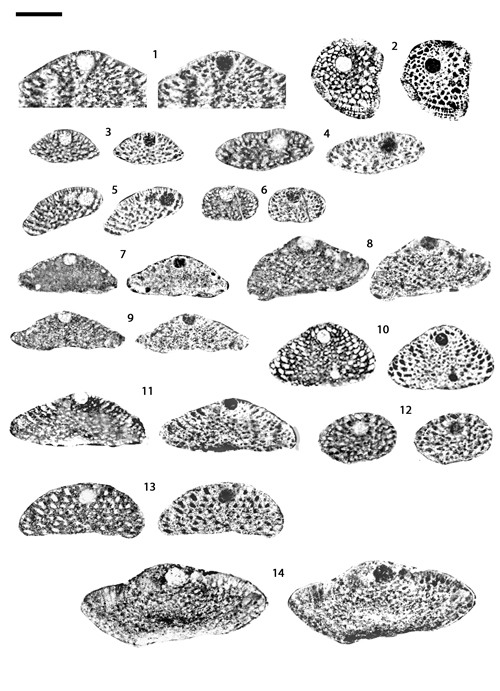
Click on thumbnail to enlarge the image.
[graphical scale bar = 500µm]

Click on thumbnail to enlarge the image.
[graphical scale bar = 500µm]
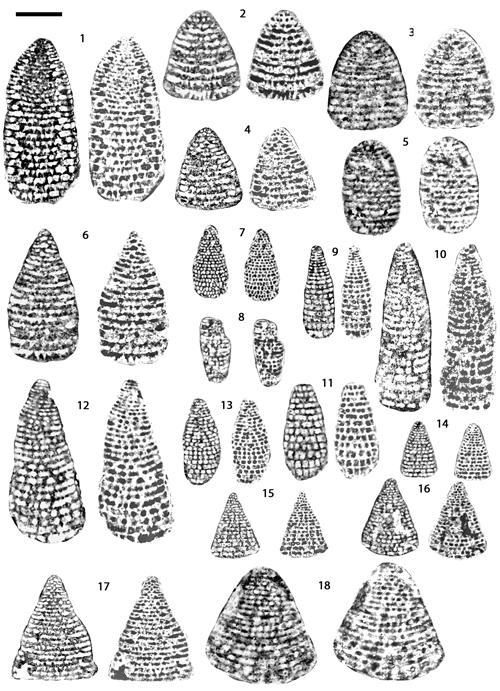
Click on thumbnail to enlarge the image.
[graphical scale bar = 500µm]
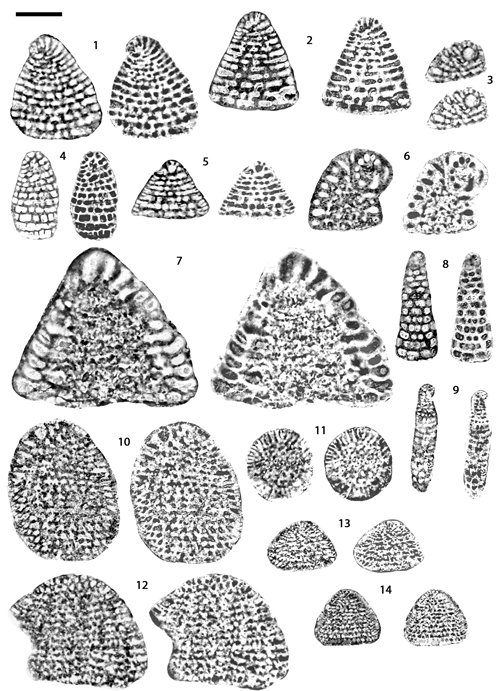
Click on thumbnail to enlarge the image.
[graphical scale bar = 500µm]
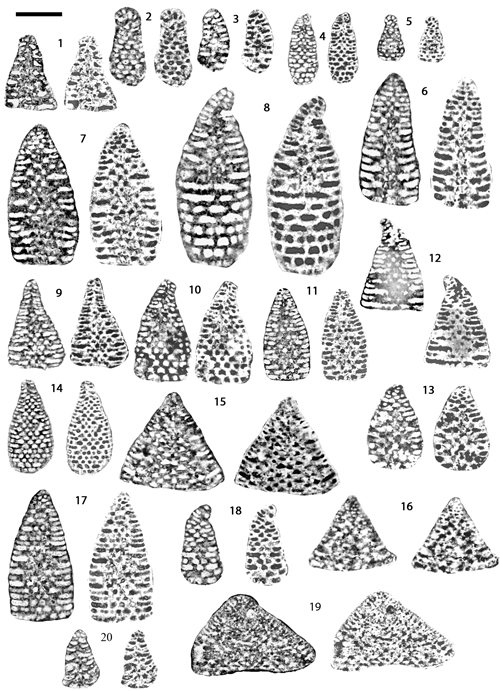
Click on thumbnail to enlarge the image.
[graphical scale bar = 500µm]

Click on thumbnail to enlarge the image.
[graphical scale bar = 500µm]
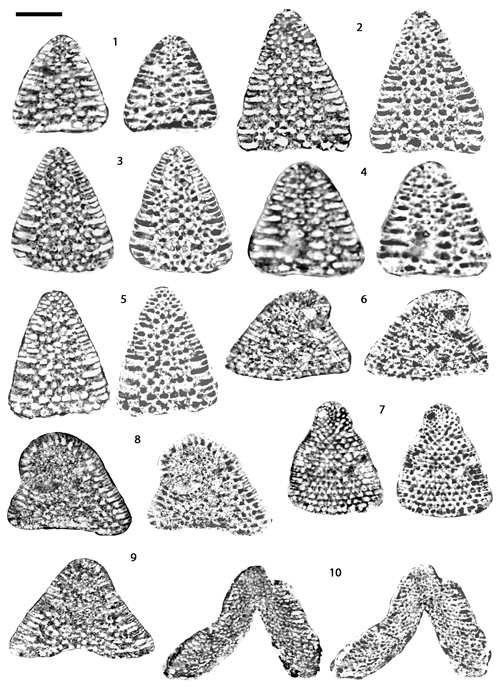
Click on thumbnail to enlarge the image.
[graphical scale bar = 500µm]
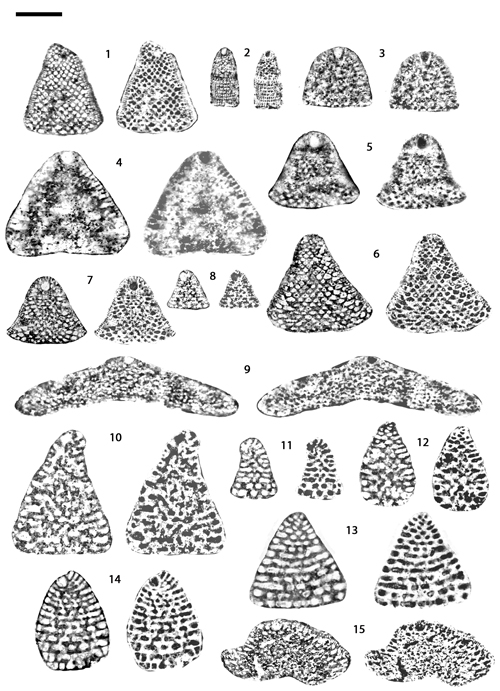
Click on thumbnail to enlarge the image.
[graphical scale bar = 500µm]
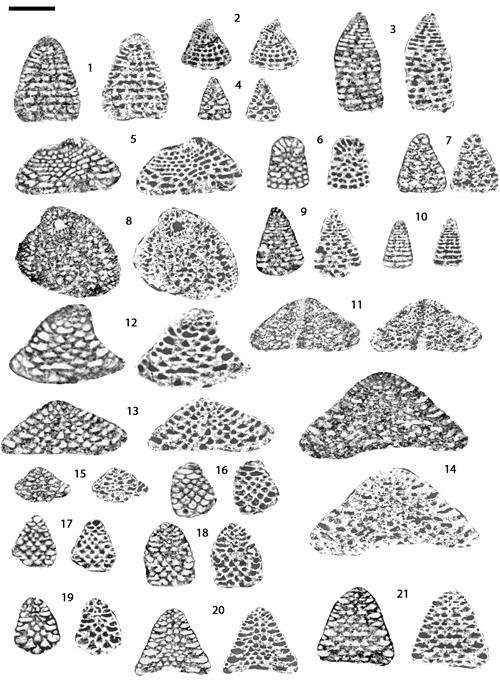
Click on thumbnail to enlarge the image.
[graphical scale bar = 500µm]
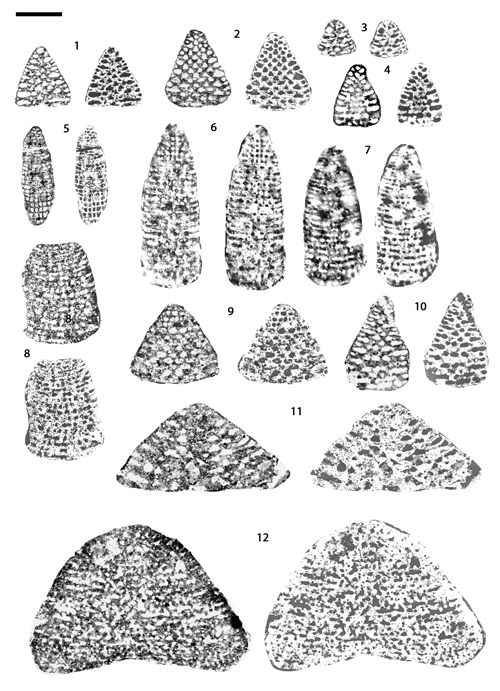
Click on thumbnail to enlarge the image.
[graphical scale bar = 500µm]
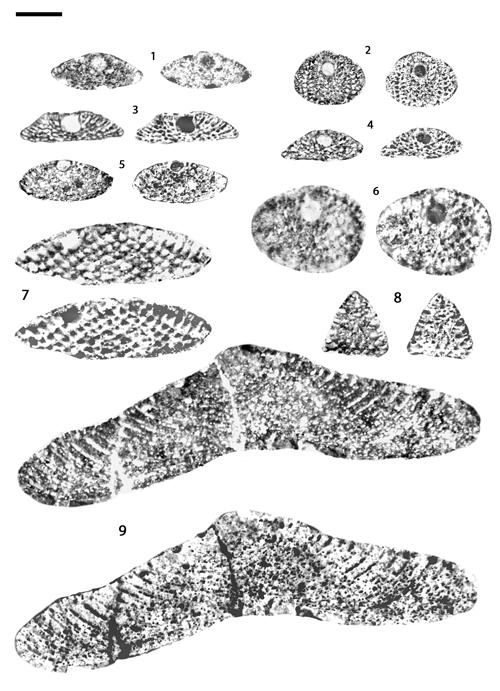
Click on thumbnail to enlarge the image.
[graphical scale bar = 500µm]